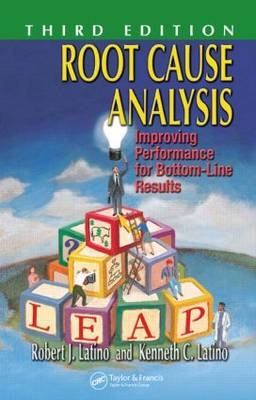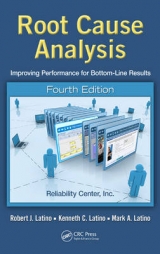
Root Cause Analysis
Crc Press Inc (Verlag)
978-0-8493-5340-6 (ISBN)
- Titel erscheint in neuer Auflage
- Artikel merken
There is no easy answer to the question, “What is RCA?” Some will give a general idea of what Root Cause Analysis (RCA) is designed to accomplish, while others will advocate a specific approach. In this third edition of the best-selling Root Cause Analysis: Improving Performance for Bottom-Line Results, acclaimed experts Robert and Kenneth Latino offer a broad look at the various types of approaches to RCA, comparing their pros and cons while supplying practical tools for implementing or improving current RCA initiatives. This edition expands the scope of RCA, taking a holistic approach that includes recent perspectives, opportunity analysis, and RCA’s fit with current initiatives such as Total Quality Management (TQM) and Six Sigma. In addition to a broader perspective, the book presents updated and expanded material including: a chapter devoted to problem-solving/brainstorming; methodology versus software; using the PROACT® approach complimented by the PROACT® Enterprise Version 3.0 software; discussion of the various conflicting definitions of common terms used in RCA; and a focus on measuring ROI.
Emphasizing the organizational support necessary for successful RCA efforts, Root Cause Analysis: Improving Performance for Bottom-Line Results, Third Edition demystifies the concepts involved in effective RCA and presents hands-on guidance for program enactment.
Introduction to the PROACT Root Cause Analysis (RCA) Work Process
Mean Time Between Failure (MTBF)
Frequency of Events
Maintenance Cost
Availability
Reliability
Balanced Scorecard
The RCA Work Process
Introduction to the Field of Root Cause Analysis
What is Root Cause Analysis (RCA)?
Why Do Undesirable Outcomes Occur? The Big Picture
Are All RCA Methodologies Created Equal?
Attempting to Standardize RCA — Is This Good For the Industry?
What is Not Root Cause Analysis?
How to Compare Different RCA Methodologies When Researching Them
What Are the Primary Differences Between Six Sigma and RCA?
Obstacles to Learning from Things That Go Wrong
Creating the Environment for RCA to Succeed: The Reliability Performance Process (TRPP)
The Role of Executive Management in RCA
The Role of a RCA Champion (Sponsor)
The Role of the RCA Driver
Setting Financial Expectations: The Reality of the Return
Institutionalizing Root Cause Analysis (RCA) in the System
Failure Classification
RCA as an Approach
Opportunity Analysis: “The Manual Approach”
Step 1: Perform Preparatory Work
Define the System to Analyze
Define Undesirable Event
Draw Block Diagram (Use the Contact Principle)
Describe the Function of Each Block
Calculate the “Gap”
Develop Preliminary Interview Sheets and Schedule
Step 2: Collect the Data
Step 3: Summarize and Encode Data
Step 4: Calculate Loss
Step 5: Determine the “Significant Few”
Step 6: Validate Results
Step 7: Issue a Report
Asset Performance Management Systems (APMS): Automating the Opportunity Analysis Process
Determining Our Event Data Needs
Establish a Workflow to Collect the Data
Employ a Comprehensive Data Collection System
Analyze the Digital Data
The PROACT® RCA Methodology
Preserving Event Data
The Error-Change Phenomenon
The 5-Ps Concept
Parts
Position
People
Paper
Paradigms
Ordering the Analysis Team
Novices versus Veterans
The RCA Team
Analyzing the Data: Introducing the PROACT Logic Tree
An Academic Example
Confidence Factors
The Troubleshooting Flow Diagram
Communicating Findings and Recommendations
The Recommendation Acceptance Criteria
Developing the Recommendations
Developing the Report
The Final Presentation
Tracking for Bottom-Line Results
Getting Proactive Work Orders Accomplished in a Reactive Environment
Sliding the Proactive Work Scale
Developing Tracking Metrics
Exploiting Successes
Creating a Critical Mass
Recognizing the Life Cycle Effects of RCA on the Organization
Conclusion
Automating Root Cause Analysis: The Utilization of The PROACT Enterprise Version 3.0+
Customizing PROACT For Our Facility
Setting Up a New Analysis in the New PROACT FMEA and OA Module
Setting Up a New Analysis in the New PROACT RCA Module
Automating the Preservation of Event Data
Automating the Analysis Team Structure
Automating the Root Cause Analysis — Logic Tree Development
Automating the RCA Report Writing
Automating Tracking Metrics
Case Histories
Case History #1: ISPAT Inland, Inc. East Chicago, IN
Case History #2: Eastman Chemical Company Kingsport, TN
Case History #3: LYONDELL-CITGO Refining Houston, TX
Case History #4: Eastman Chemical Company World Headquarters Kingsport, TN
Case History #5: Southern Companies Alabama Power Company Parrish, AL
Case History #6: Weyerhauser Company Valliant, OK
Index
| Erscheint lt. Verlag | 5.5.2006 |
|---|---|
| Zusatzinfo | 40 Halftones, black and white; 32 Tables, black and white; 207 Illustrations, black and white |
| Verlagsort | Bosa Roca |
| Sprache | englisch |
| Maße | 156 x 235 mm |
| Gewicht | 522 g |
| Themenwelt | Technik ► Maschinenbau |
| ISBN-10 | 0-8493-5340-8 / 0849353408 |
| ISBN-13 | 978-0-8493-5340-6 / 9780849353406 |
| Zustand | Neuware |
| Informationen gemäß Produktsicherheitsverordnung (GPSR) | |
| Haben Sie eine Frage zum Produkt? |
aus dem Bereich



